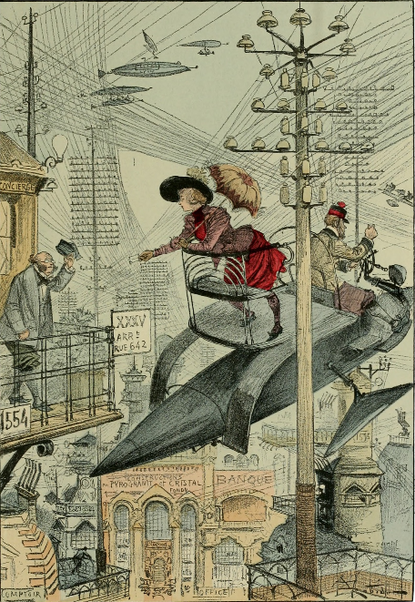incertae sedis. Pinar Yoldas: Your Desiring Deviant Body
Pinar Yoldas is probably a crossbreed of Pinocchio’s father Mister Geppetto and the revolutionary Frankenstein. An interview with this Turkish-born artist working in the USA now has been my driving ambition since last year when I came across her project Speculative Biologies (2011). For this work Pinar Yoldas designed fictional neoplasmic organisms SuperMammal, MegaMale and NeoLabium using tissue engineering technology and being inspired both by form and structure of male and female sexual organs. These queer-personages live in chemical-lab-like glass containers challenging the contemporary imagination about grotesque beauty, pure desire, and untamed sexuality. They resonate with an ironic painting by Ukrainian artist Sergiy Zarva called “Glossy Ghoulism”. If Peter the Great was told about Pinar’s future creations he would definitely commission her artworks for the Kunstkamera to be exhibited there 300 years after his epoch.
Pinar’s artworks typify the neurotic condition of contemporary world overloaded with mutations, ecological catastrophes, and insane experiments in science and technology. Her hybrid art objects make us think about the desire for new knowledge not limited by the consideration of ethics. Moreover, the ethical responsibility for her own creations transforms into speculation and intellectual irony in Pinar’s case. If growing organs is such a promising direction in medical sciences nowadays, why should the human limit herself by having just a transplanted tooth, kidney or finger? In the era of naturalness of silicone and liposuction, artificial organs designed by Pinar no longer look just playful.
This is not the only direction Pinar Yoldas is working in. You will definitely enjoy playing her arcade game for iPhone called Sparticle, which will immediately swallow you into exploring different worlds with its cool graphics and the ability to teleport through endless gates. Additionally to her cross-disciplinary practice in bio-art, art-neuroscience and subversive gaming interfaces, you should also keep in mind that Pinar holds a bronze medal in organic chemistry in the national science olympics.
Pinar Yoldas is an award-winning artist, theorist and researcher. She graduated from the University of California Los Angeles (Media Arts department , MFA in 2008), Istanbul Technical University (MS in Information Technologies, 2006), Istanbul Bilgi University (MA in Visual Communication Design 2004), and Middle East Technical University (Bachelor of Architecture, 2002).
Pinar is currently a PhD student in Visual and Media Studies program at Duke University, where she's pursuing a certificate in the Center for Cognitive Neuroscience. Pinar has been awarded numerous fellowships in art and science venues including the MacDowell Colony, UCross Foundation , VCCA, National Evolutionary Synthesis Center, and Ars BioArctica residency. She is the current recipient of the Transmediale Villem Flusser Art/Theory Award for her project “an Ecosystem of Excess” where she approaches the problem of “man-made extreme environments” like landfills, junkyards etc. caused by an excessive consumerism from an ironic and critical viewpoint.

Lilia KUDELIA Pinar, I adore the quote by J.G.Ballard you have posted on your Tumblr: "Neuroscience is the Sistine Chapel of Science". Being an artist you also introduce yourself as a designer and a neuro-enthusiast. How did you arrive to the idea of creating art in relation to science and biological systems in particular? And do you have some phenomenon or term from the neuroscience thesaurus to compare your art with?
Pinar YOLDAS Creating art in relation to science and biological systems was not even an option for me, it was a necessity for personal and more global reasons. Science and technology are two major factors that shape our culture and our lifestyles as well as capturing our collective imagination. The scientific narrative brought with itself a new sensory vocabulary, images, and sounds of the many dimensions unknown to us have been released to our sensorium. I have always been interested in science and science-fiction. I remember the day I discovered Yevgeni Zamyetin and Ursula K. Le Guin at the same time as a 14 year old. Madame Curie was as important a role model for me as Marcel Duchamp. Although I had had a solo exhibition at the age of five, by 15 I decided to study organic chemistry. I moved freely between art and science like a happy bee without actually hitting the institutional borders that separate the two. To answer your last question, I call myself a “synaptic sculptor”. With my work I hope to transform the connectome of the brain, by establishing new connections, stimulating new ideas, new visions.
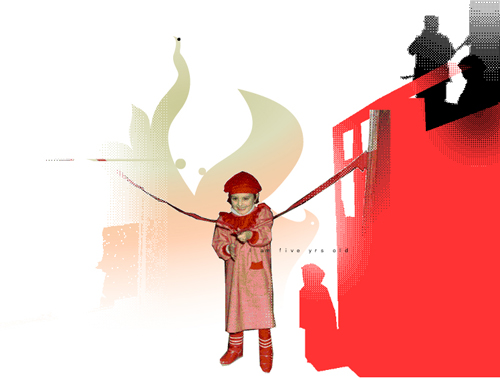
5-years-old Pinar Yoldas cutting the red ribbon at her first solo exhibition opening
- Your recent project “Speculative Biologies” (2011) investigates the nature of pleasure through new living species that you have engineered and grown. These terrifically designed genitals – pure organs of satisfaction – make me think of sexual biography written by Cathrine Millet. In “The Sexual Life of Catherine M.” (2001), Millet emphasizes that the pleasures of solitude are easy to describe whereas love acts between couples could not be grasped even in bare outlines. After Millet expressed her own experience of searching for sexual pleasures, a film writer Chantal Thomas said: “This book attracts because it is not about crossing the forbidden border, but about the absence of boundaries as such.” Your art species are based on the same philosophy of freedom of sexual expression. Despite quite speculative, they do try to speak about sex as a non-sacral phenomenon intrinsic to human. Do you really envision this project as a platform for discussing the new quality of human eroticism, for example, the relationships that would be more open and tolerant towards understanding and expressing sexual desires?
- "Speculative Biologies" suggests new tissues, new organs and new bodies that exist beyond the infamous Cartesian dichotomies such as man/woman or mind/body. “Speculative Biologies” are fictitious, they are designed to stimulate our biological imagination, they are designed to challenge the anatomical norms around sex and gender. Let’s take “NeoLabiumTM” for example.
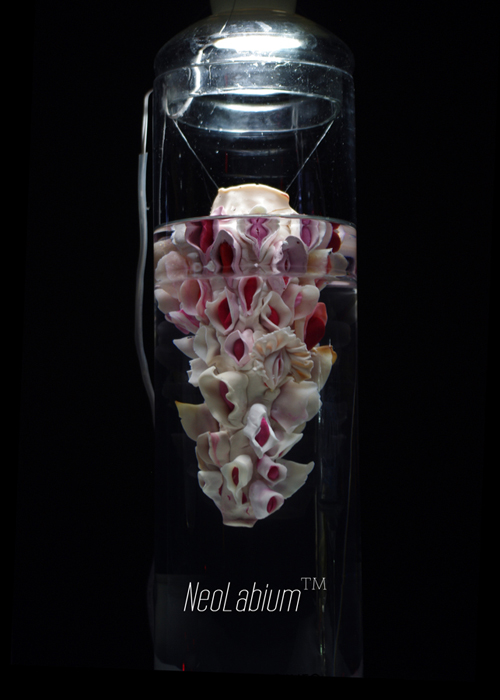
The primary goal of NeoLabiumTM is to multiply, intensify and purify sensation. On top of the 8000 nerve endings a healthy glans clitoris is endowed with, NeolabiumTM has an additional 8000 more. Between labia minora and labia majora NeoLabiumTM holds Labia SyntheticaTM, an enhanced labia that has more than 3000 nerve endings. The cutaneous substructures of Labia SyntheticaTM carries sophisticated nerve receptors that are designed to create a sensation of pure pleasure. With all its revamped pleasure production capabilities, NeoLabiumTM is a necessary update to the female anatomy. In a world where sexual pleasure is denied to women under the name of religion, tradition or law the amplified pleasure toolkit of NeoLabiumTM is a flowery weapon of flesh, designed to be highly noticeable, detectable and discernible.
NeoLabiumTM, is like the face. It is a bodily surface that is always on display, a surface that cannot be dismissed scotopically. You may be genotypically XY but still have this conventionally female organ. That is, independent of the biological sex of the hosting body, NeoLabiumTM is plug and play. Its modularity allows a vast array of interesting permutations. For instance a biologically male brain after the implantation of NeoLabiumTM, would enter synaptogenesis under the influence of a conventionally female sex organ. Therefore, NeoLabiumTM not only offers intersexed bodies but intersexed minds. SuperMammalTM, PolyPhalliiTM, Fontis UrethraTM all follow a similar logic, that is to blur the borders between the two sexes by creating almost chimeric sexed bodies.

- I am wondering what artists or writers did you draw your inspiration from for this piece. You mentioned about the artist Janaina Tschape and her “contemporary organic abstraction”. Georges Battaile’s prose describing various excess manifestations of flash could be also a great source of stimulation for you to design the “Speculative Biologies”. Who else were you inspired by?
- I am mostly drawn to artists and creators that are highly transgressive and amoral. But I’m not talking about simple plain almost banal perversity. I am aware but definitely not interested in let’s say darker, ritualistic aspects of transgression. I am interested in intellectual provocateurs. Therefore Bataille makes it to the list very easily, so does J.G. Ballard. I already mentioned some of my favorite sci-fi writers, Ursula k. Leguin for instance. Samuel Delaney, Margaret Atwood even Murakami’s magical realism speaks to me. The list of visual references would not fit within the limits of this interview. Like Picasso said , I steal from countless image references all the time.
I have been reading a lot of D’arcy Thompson, Jacob von Uexkull, Arne Naess and Elizabeth Grosz for my research. I also read neuroscience articles for my coursework mostly. I just finished one in STS (Superior Temporal Sulcus) and biological motion. Instantly a project popped out in my head as I was reading.
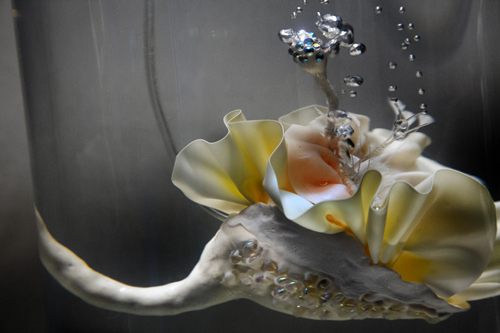
- How long does it usually take you to grow these species?
- Hmm, I think SuperMammalTM was the first and took a year and a half. It depends on the anatomical challenges but I would say a couple years on average.

- What if people would like to transplant these organs to their own bodies? For example, have you ever thought of an art collector interested to buy your artwork in order not to be hung on a wall/put in the gallery, but displayed on his(her) own body?
- That would be wonderful. As I mentioned above these “designs” are meant to be plug and play. There’s an art duo Art Orienté Objet, and in their piece May the Horse Live with Me Lavaljeanet injected horse immunoglobins in her bloodstream. The entire piece was about this transformation or juxtaposition of two species. I think about a male collector with NeoLabiumTM How would he feel? How would he transform? Do hybrid bodies really create hybrid minds? That is my hypothesis that needs to be tested. But you know there are a lot of limitations with tests on human subjects. Regardless I would be happy to customize them for personal use.

- How far could you push yourself in speculating with controversial issues in your art practice?
- Not that far I would say compared to some of the performance artists of the past century. I definitely will not ask someone to shoot me (Chris Burden), I will not insert a scroll of paper in my vagina ( Carole Schneeman), I will not have a dozen aesthetic surgeries to look like Mona Lisa (Orlan)... That said, I don’t think there are any limits.
- Literally, in “Speculative Biologies” you are making the invisible visible – as if people should expect the regeneration of their skin. I am curious to ask your opinion about what could be further implications of this project in fashion? The question comes to mind because of some cutting-edge experiments on the verge of fashion, science and technology. For example, a new collection by Iris Van Herpen is grounded on the idea of electricity transmitted through woman body. There are some important older collections by Hussein Chalayan (2007) where he incorporated LED technology in order to make dresses move and react on light source. Both art and fashion worlds are extensively pushing the human towards acquiring a cyborg-creature identity…
- Speculative Biologies could be considered a fashion design project as long as abdominal fat or silicon breasts are fashion. I do try to make these neo-organs look good that’s for sure but I do not consider them clothes. As for experimental design projects, that’s a reflection of the invasive scientific and technological thinking that governs our time. Also let us remember that the shelf life of styles and forms especially in the world of fashion is very short. These industries, design and fashion, always seek novelty. I love Herpen and Chalayan’s work, yet they’re the equivalent of what Greg Lynn is for architecture. Innovative form givers that satiate the need for novelty and creativity for the global elite. And unfortunately these interesting designs stop there and cannot go further. Since Donna Haraway’s Cyborg Manifesto it is an established view that we are all cyborgs, that is technological bodies. There’s nothing new there. But as technological bodies are we going to stay within the limits of patriarchal thinking or are we going to expand and create a new culture that can answer the needs of a composite, chimeric body? Let’s Ballard it up here : ““Fashion: A recognition that nature has endowed us with one skin too few, and that a fully sentient being should wear its nervous system externally.” We wear what we want to be.

- I am fascinated with your grotesque Arcimboldo-like drawings and collages (i.e.“Reproduction Engine” and “Ultravirgin MMXI”). There is an obvious relation between these works composed of an abundant amount of intertwined sexual organs and the tissue engineered objects. Could you speak more about your creative process and how do you develop ideas? Can your drawings, for example be considered as preparatory stages for designing the real species?

Drawing by Pinar Yoldas
- There’s a reciprocal relationship between the drawings and everything else. I started drawing when I was two, and never stopped ever since. Pinar who draws is a very essential part of my identity and I am so grateful to my parents that I was raised this way. After a certain stage or after you reach a certain level of confidence with drawing you can simply do anything. Drawing is my primary source of inspiration and the most immediate medium that allows me to try out new forms. In terms of my creative process though, most ideas just pop up in my head. I guess I reach a certain threshold after reading and thinking and reading and thinking and looking and doing that a very precious drop of essence gets distilled and is released to my consciousness, or perhaps a weird connection is established between the ten thousand things I am interested in. With drawings it is a quite different process, when I draw if I’m only drawing (not sketching out a new idea,) I go with the flow and just witness that silent interaction between my sensorimotor skills and the rest of my body. My body usually knows what to do.

Drawing by Pinar Yoldas
- Do you consider videogames a part of an art system, an art genre in other words? Based on your own experience in designing video games, what do you think would be the next evolutionary phase in gaming industry?
- This is a tough question. Gamins is very interesting to me and I find myself stimulated by the work of character designers such as Yoshitaka Amano. The power of gamins lies in its immersive and multimodal quality. The notion of action is introduced with gaming. In music, theater, painting although your head is actively responding to what’s going on before you, your body is generally still and does not move. In gaming you have to respond and walk and navigate and explore and shoot and collect mushrooms etc. etc. I think gaming industry is moving towards making the game set-up as invisible as possible. The body as a wholistic entity is becoming the game console. Invasion of the visual field and auditory field are necessary. To blur the borders between reality and the game is the ultimate goal. I see an entire nation of people whose real life is their game life. My personal question is can that game life have more art to it? Can it be a fulfilling and forward-looking aesthetic experience rather than a technological manipulation of the basic hunter-gatherer instincts ?
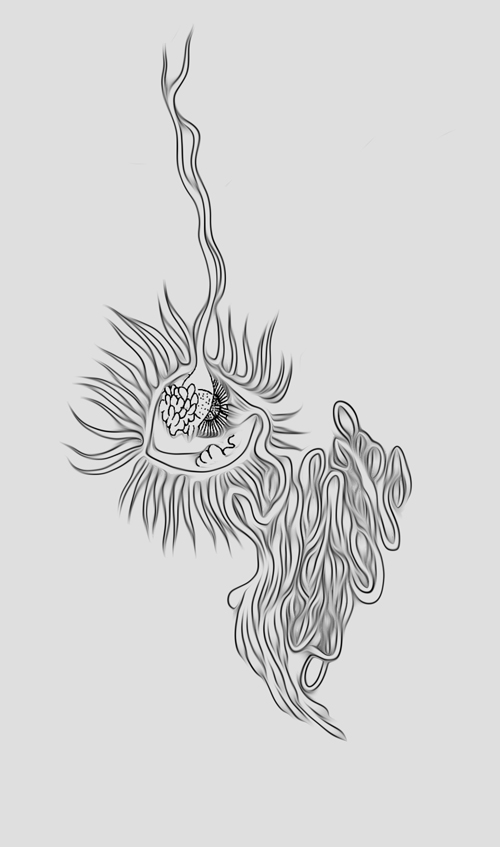
Drawings by Pinar Yoldas
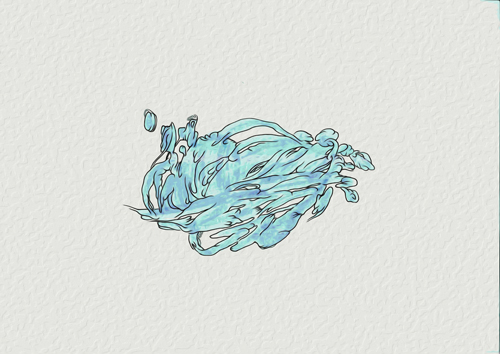
- How does discovery of new scientific facts challenge your ways of seeing? Also, have you ever thought about the influence of scientific illustration aesthetics on your artistic style?
- Absolutely. Starting from Ernst Haeckel and Ramon Y Cajal I admire the marriage of early modern science with illustration. In terms of new scientific facts it is hard to keep up just by following “ I fucking love science”s FB or tumblr. I spend most of my time in the Cognitive Neuroscience department here and what I learn in neuroscience definitely shapes the way I think.

Pinar’s favorite scientific illustrations
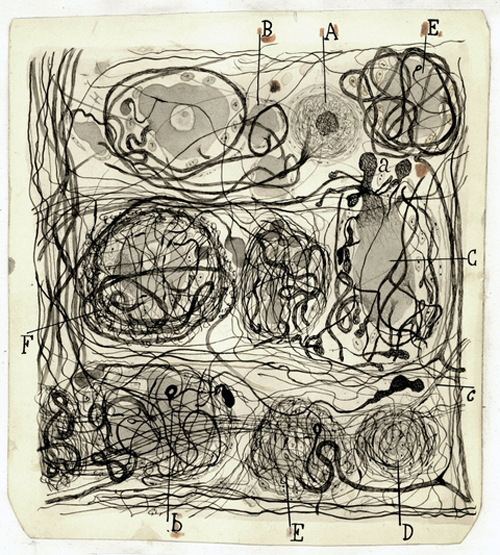
- During your art career, what has been your most influential collaboration with scientists so far?
- All of them. Every single collaboration has been very influential and transformative. I expect more to come.
- Since you have been working in different cities recently, I am curious to ask where the science art scene is more vibrant: in Los Angeles or in New York? What place is the most comfortable for you to develop and implement new ideas?
- Another tough question. I love Los Angeles , I just can’t help loving it despite it’s very unsustainable structure and the smog and the traffic. There’s something about California that just speaks to my psyche ( hint : its mediterranean climate). New York can be overstimulating at times and I do enjoy my quiet peaceful life here at Duke University. Interdisciplinary research environments are the best since they attract all kinds of brilliant people working in different disciplines.
- As an insider, could you speak to us more about how widespread the new technology of tissue engineering is among bio artists? Do other people in art grow tissues and organs similarly as you do?
- Oron Catts and Ionat Zurr who founded Symbiotica could also be considered the founders of this field in my opinion, oh together with Joe Davis of course and Critical Art Ensemble and Steve Kurtz. Phil Ross is an amazing human being who also works in this field who also curated an equally amazing show called BioTechnique. There’s Hackteria who deliver workshops in Do-It-Yourself biology. The list goes on.


Lilia Kudelia
All images: courtesy of the artist



